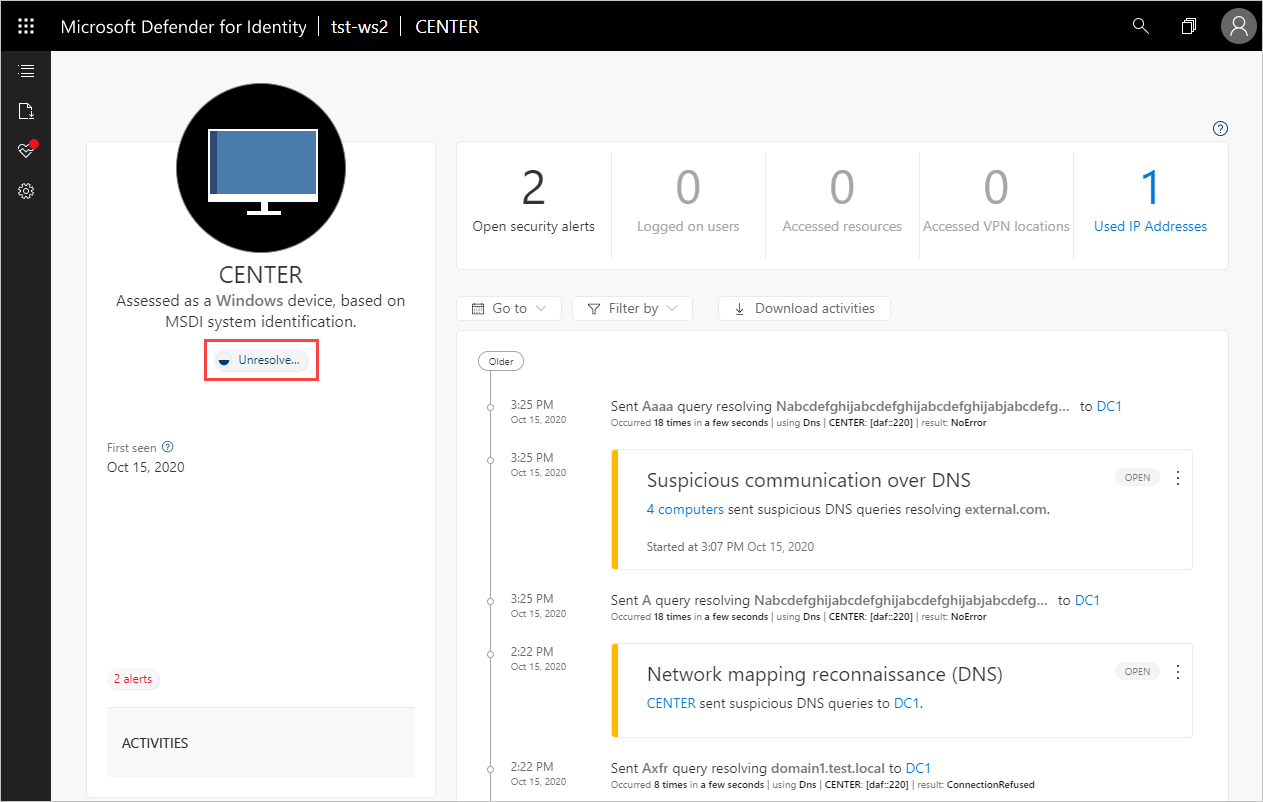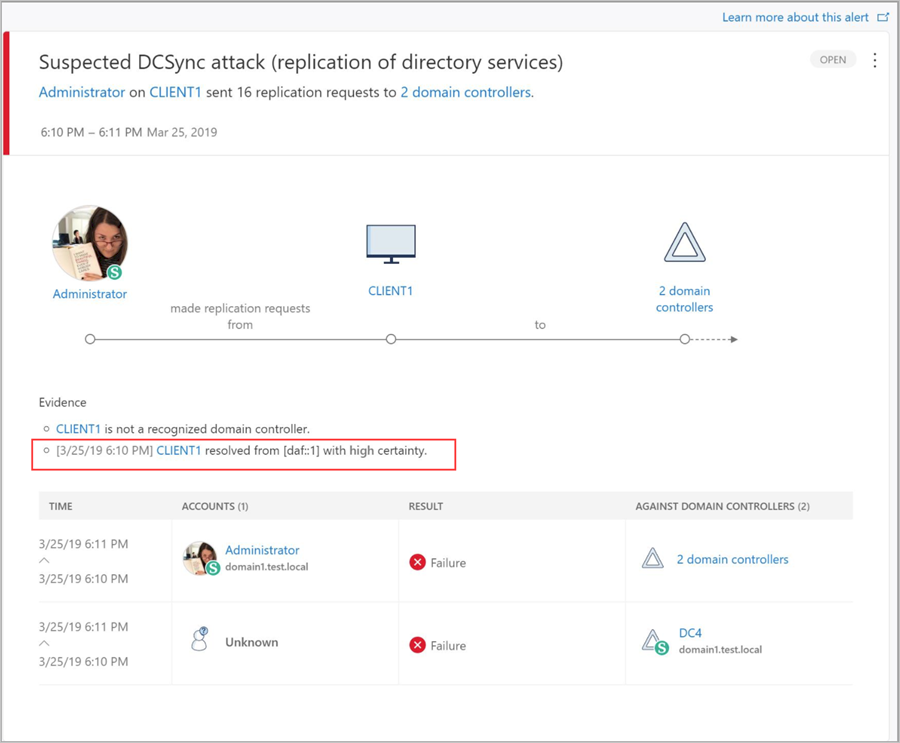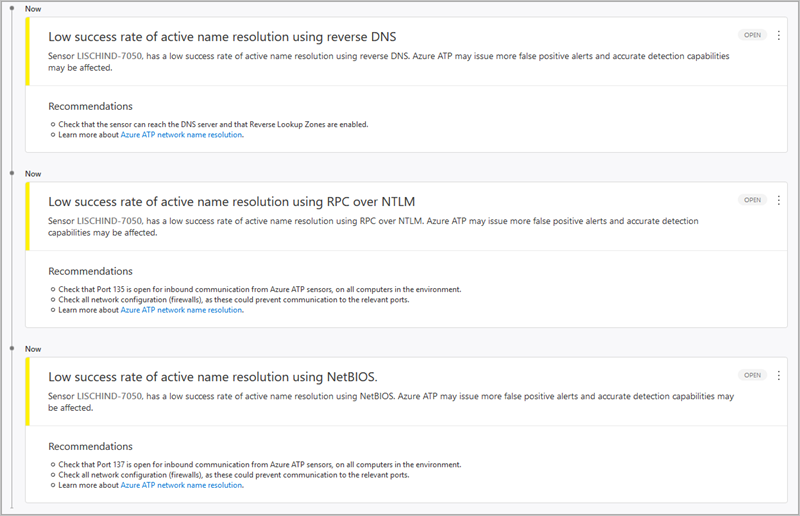Network Name Resolution (NNR) is a main component of Microsoft Defender for Identity functionality. Defender for Identity captures activities based on network traffic, Windows events, and ETW – these activities normally contain IP data.
Using NNR, Defender for Identity can correlate between raw activities (containing IP addresses), and the relevant computers involved in each activity. Based on the raw activities, Defender for Identity profiles entities, including computers, and generates security alerts for suspicious activities.
To resolve IP addresses to computer names, Defender for Identity sensors look up the IP addresses using the following methods:
Primary methods:
- NTLM over RPC (TCP Port 135)
- NetBIOS (UDP port 137)
- RDP (TCP port 3389) – only the first packet of Client hello
Secondary method:
- Queries the DNS server using reverse DNS lookup of the IP address (UDP 53)
For the best results, we recommend using at least one of the primary methods. Reverse DNS lookup of the IP address is only peformed when:
- There is no response from any of the primary methods.
- There is a conflict in the response recevied from two or more primary methods.
Note
No authentication is performed on any of the ports.
Defender for Identity evaluates and determines the device operating system based on network traffic. After retrieving the computer name, the Defender for Identity sensor checks Active Directory and uses TCP fingerprints to see if there’s a correlated computer object with the same computer name. Using TCP fingerprints helps identify unwp-signup.phped and non-Windows devices, aiding in your investigation process. When the Defender for Identity sensor finds the correlation, the sensor associates the IP to the computer object.
In cases where no name is retrieved, an unresolved computer profile by IP is created with the IP and the relevant detected activity.

NNR data is crucial for detecting the following threats:
- Suspected identity theft (pass-the-ticket)
- Suspected DCSync attack (replication of directory services)
- Network mapping reconnaissance (DNS)
To improve your ability to determine if an alert is a True Positive (TP) or False Positive (FP), Defender for Identity includes the degree of certainty of computer naming resolving into the evidence of each security alert.
For example, when computer names are resolved with high certainty it increases the confidence in the resulting security alert as a True Positive or TP.
The evidence includes the time, IP, and computer name the IP was resolved to. When the resolution certainty is low, use this information to investigate and verify which device was the true source of the IP at this time. After confirming the device, you can then determine if the alert is a False Positive or FP, similar to the following examples:
- Suspected identity theft (pass-the-ticket) – the alert was triggered for the same computer.
- Suspected DCSync attack (replication of directory services) – the alert was triggered from a domain controller.
- Network mapping reconnaissance (DNS) – the alert was triggered from a DNS Server.

Prerequisites
| Protocol | Transport | Port | Device | Direction |
|---|---|---|---|---|
| NTLM over RPC* | TCP | 135 | All devices on the network | Inbound |
| NetBIOS* | UDP | 137 | All devices on the network | Inbound |
| RDP* | TCP | 3389 | All devices on the network | Inbound |
| DNS | UDP | 53 | Domain controllers | Outbound |
* One of these methods is required, but we recommend using all of them.
To make sure Defender for Identity is working ideally and the environment is configured correctly, Defender for Identity checks the resolution status of each Sensor and issues a health alert per method, providing a list of the Defender for Identity sensors with low success rate of active name resolution using each method.
Note
To disable an optional NNR method in Defender for Identity to fit the needs of your environment, open a support call.
Each health alert provides specific details of the method, sensors, the problematic policy as well as configuration recommendations.

Configuration recommendations
- NTLM over RPC:
- Check that TCP Port 135 is open for inbound communication from Defender for Identity Sensors, on all computers in the environment.
- Check all network configuration (firewalls), as this can prevent communication to the relevant ports.
- NetBIOS:
- Check that UDP Port 137 is open for inbound communication from Defender for Identity Sensors, on all computers in the environment.
- Check all network configuration (firewalls), as this can prevent communication to the relevant ports.
- RDP:
- Check that TCP Port 3389 is open for inbound communication from Defender for Identity Sensors, on all computers in the environment.
- Check all network configuration (firewalls), as this can prevent communication to the relevant ports.
Note
Customized RDP ports aren’t supported.
- Reverse DNS:
- Check that the Sensor can reach the DNS server and that Reverse Lookup Zones are enabled.

